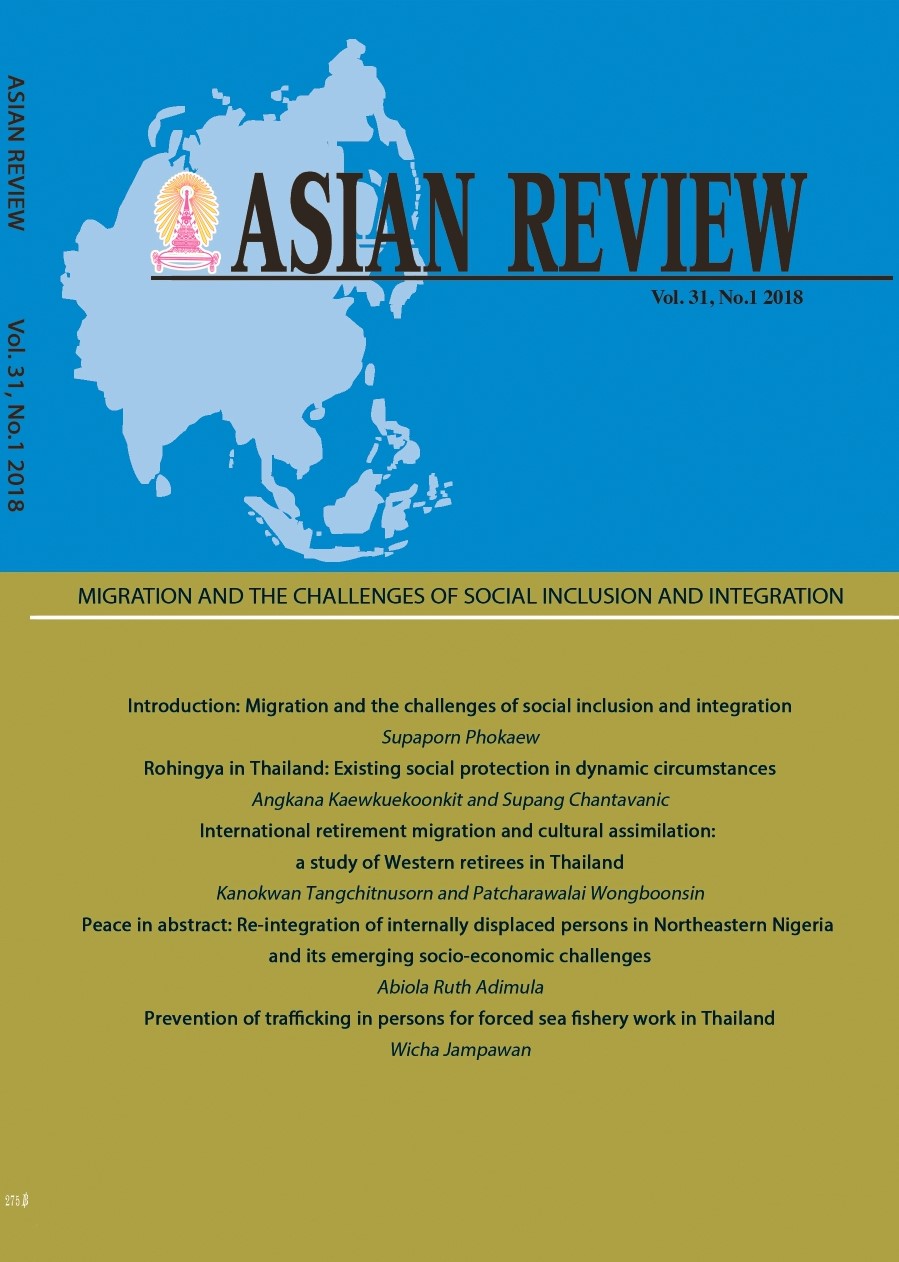Prevention of trafficking in persons for forced sea fishery work in Thailand
Keywords:
Trafficking in persons, forced labor, sea fishery, migrant workers, Rational Choice, Deterrence, Five Ps StratediesAbstract
Sea fishery is an important economic sector for Thailand that brings in huge national revenues. However, it is avoided by most Thai workers due to its dangerous and exploitative nature thus creating a labor shortage in this sector. To fill in the gap, the Thai government has devised a time-bound registration of foreign workers to attract migrant labor from Cambodia, Lao PDR and Myanmar. Recruitment agents take advantage of this loophole by herding the influx of migrant workers through deceptive and exploitative arrangements, thus allowing trafficking in persons to flourish. This has put Thailand under heavy international scrutiny and trade sanctions to which the Thai Government has responded by launching the Five Ps Strategies of Prevention, Prosecution, Protection, Policy and Partnership. This paper aims to examine public and private measures to prevent trafficking in persons for forced sea fishery work in Thailand, through documentary research and in-depth interviews with key informants at study sites in Samut Sakhon, Rayong and Songkhla provinces in 2015 when CCCIF started its operation. Prevention in this study means all actions that are inclusive in the Five Ps. Research findings show that the results of the Five Ps Strategies have not been optimum. Factors contributing to the inefficient prevention work include weak law enforcement, overlap of duties and responsibilities among the authorities; inadequate operating budgets; small numbers and frequent changes of responsible actors; and, a narrow interpretation of the term ‘trafficking in persons’ in Thai laws.
References
Becker, Gary S.1968. “Crime and Punishment: An economic approach.” Journal of Political Economy 76(2): 169-217
Chotika Chummee.2014. U.S.A. reduced Thailand to Tier 3 as shown in trafficking in Persons Report 2014. https://www.scbeic.com/THA/document/flash_20140623_tier/
Chulalongkorn University.2015.Dialogue and Declaration on Rescuing Thai and International Crews “Stranded at Umbon Island: Is it stranded crew, trafficking labor and trafficking crew?” http://www.ias.chula.ac.th/ias/th/Seminar-Detail.php?id=10
Department of Fishery.2015.Strategies of Department of Fishery B.E. 2013-2016. http://www. fisheries.go.th/planning/files/info/strategy56.pdf
ILO and Asian Research Center for Migration 2013. Employment Practices and Working Conditions in Thailand’s Fishing Sector.
International Labour Organization.2012.21 million people are now victims of forced labour, ILO says. http://www.ilo.org/global/about-the-ilo/newsroom/news/WCMS_181961/lang--en/index.htm
International Labour Organization.2015.Elimination of Forced Labor. http://www.ilo.org/ washington/areas/elimination-of-forced-labor/lang--en/index.htm
Jarupat Panichying.2014.This is...Trade Barriers. http://www.exim.go.th/doc/adn/44589_0.pdf
Nattaya Srichuntuk.2014. Summary on production and export fisheries products situation in 28 October 2014. http://fishco.fisheries.go.th/fisheconomic/Doc/news2.pdf
Office to Monitor and Combat Trafficking in Persons, USA. Trafficking in Persons Report. June 2014. Page 372. https://www.state.gov/documents/organization/226849.pdf
Pornchai Kunthee.2010. Criminology Theories: Research Principles and Adapted Policies. First Print. Bangkok: Sunet Film Limited Partnership
Prachathai.2015.Human Trafficking Report 58 U.S.A ranked Thailand almost the last for the second consecutive years. http://prachatai.com/journal/2015/07/60560.
Sanphasit Koompraphant and Payonsri Kunthikul.2005. Solution measures on Human Trafficking particularly Women and Children. Bangkok Metropolis, the Thailand Research Fund.
Sunee Sri-sa-nga-trakul-lert.2015.Implementation of policies, strategies and measures to prevent and suppress trafficking in persons: Action plan to prevent and suppress trafficking in persons for the fiscal years 2013 to 2015. https://www.m-society.go.th/download/ article/article_20150824094949.pdf
Tittle, C. R.1969. Crime rates and legal sanctions. Social Problems, 16, 409–423.
Thai Government.2015.Prime Minister Announcing “Human-Trafficking Suppression” as the National Agenda. http://www.thaigov.go.th/index.php/th/government-th1/item/91126-id91126
Thailand: Anti-Trafficking in Persons Act B.E 2551.2008. [Thailand], 30 January 2008. http:// www.refworld.org/docid/4a546ab42.html
Thailand Development Research Institute.2014. New Era for Migrant Workers Employment. http://tdri.or.th/tdri-insight/alien-labour/
Wanthanee Wasikasin and Prathaeng Chauyklaeng.2009. Human Trafficking comparative Study between Laos and Cambodia: Prevention and Solution. Bangkok Metropolis, Human Resource Institute, Thammasat University.
United Nations.2004.United Nations Convention against Transnational Organized Crime and the Protocols Thereto. https://www.unodc.org/documents/treaties/UNTOC/Publications/ TOC%20Convention/TOCebook-e.pdf
UNODC.2009. International Framework for Action to Implement the Trafficking in Persons Protocol. https://www.unodc.org/documents/human-trafficking/Framework_for_ Action_TIP.pdf.
UNODC. 2015. What is Human Trafficking? https://www.unodc.org/unodc/en/human-trafficking/ what-is-human-trafficking.html
Zimring, Franklin and Gordon Hawkins. 1973. Deterrence. Chicago: University of Chicago Press
Downloads
Published
How to Cite
Issue
Section
License
Published articles are under the copyright of the Instiute of Asian Studies, Chulalongkorn University. Partially or totally publication of an article elsewhere is possible only after the consent from the editors.







